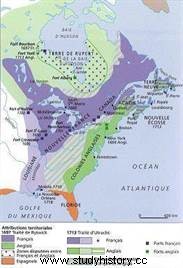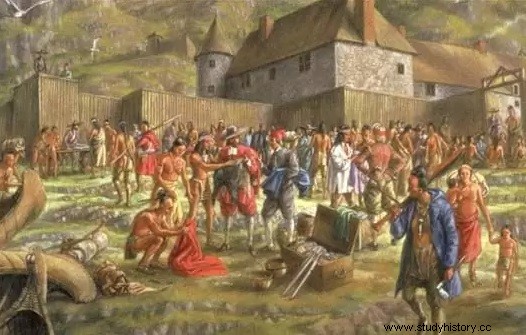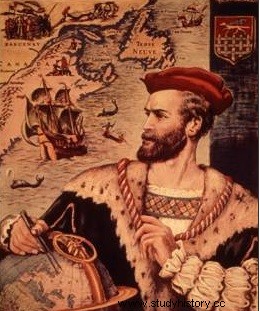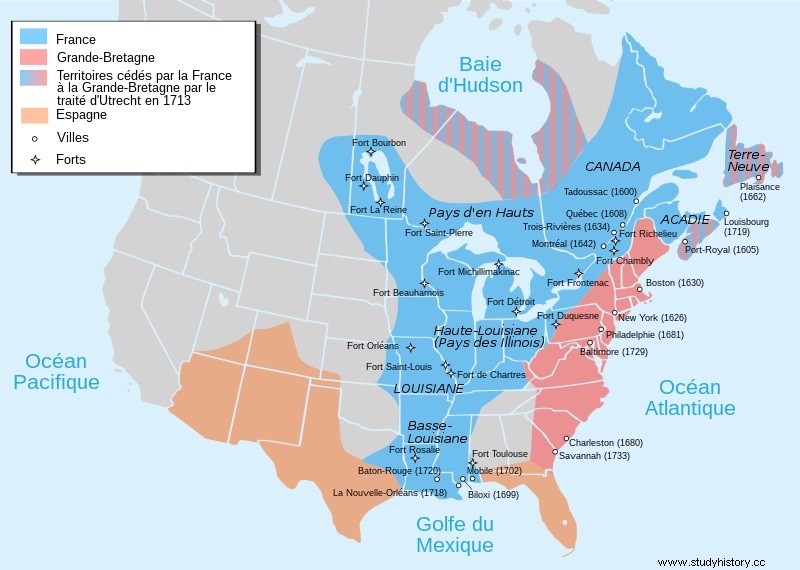 We often tend to forget that North America was not always Anglo- Saxon. It was even, with India, the first French colonial empire, from Quebec to New Orleans. From the beginning of the 16th century, courageous and intrepid explorers surveyed the new world, from the mouth of the St. Lawrence to the swampy delta of the Mississippi, passing through the region of the great lakes, in search of a hypothetical passage to the east. Soon followed by settlers from western France and by missionaries, they founded New France, an immense colony that then covered more than half of the North American continent. The history of New France begins in 1524. King François 1st decides that it is high time to tease his rival Charles V overseas, and sponsors an expedition which is entrusted to the Italian Verrazano. This one goes up the Atlantic coast from Florida, in search of a passage to China, discovering on the way Acadia, in eastern Canada. A few years later, François 1er entrusted Jacques Cartier with the mission of continuing the exploration of this region and founding a colony there. Cartier explores the mouth of the St. Lawrence then goes up the river, but his expedition is swept away by illnesses, and he is unable to establish a colony. Entangled in the wars of religion, French royalty quickly lost interest in this hostile country where no gold was found. The few attempts at settlement that followed during the second half of the 16th century were hardly more fruitful, but were rich in lessons for the expeditions that resumed more seriously under the reign of Henry IV. Counters were created in Acadia, which would later be the object of a fierce struggle between the English and the French, and Samuel de Champlain founded the city of Quebec in 1608. To consolidate a precarious position and protect the fur trade, Champlain makes an alliance with Indian tribes including the Huron, attracting the animosity of their Iroquois rivals. Stuck in the middle of rivalries between Indians, this embryo of colonization, whose economy is based on fishing, agriculture and the fur trade, is struggling to develop, for lack of settlers in sufficient numbers. There were only a few hundred when Champlain died in 1635 while the English, fleeing religious persecution, settled by the thousands on the east coast of the United States. A new dynamic was driven by a company of missionaries who founded the city of Montreal in 1639, which strengthened the French presence by adding a religious and social vocation. The rise of New France really began in 1663 under Louis XIV, who transformed the colony into a royal establishment under his direct control and that of Colbert. A governor and a steward are appointed by the king to administer the colony, now defended against the Indians and the English by a royal regiment. The mainly male local population was reinforced by the sending of the "King's Daughters", a contingent of young orphans endowed by the sovereign and sent to the new world. Coming mainly from the west of France, the candidates for departure remain few in number. The French peasant was hardly enthusiastic about the idea of crossing the seas to find a lord and a priest in these harsh regions, among more or less pleasant Indians. Thus, despite these more or less voluntary attempts at immigration, the New -France remains an underpopulated immensity, essentially made up of counters and military forts, and under the constant threat of the English and the Iroquois. A rivalry that escalated from 1670 with the dazzling development of English colonies established on the coast and progressing towards the interior of the continent, trying to capture the profitable fur trade. A tension that escalates when French colonization progresses in the direction of the southwest with the discovery and taking possession of the territories of the Mississippi and the foundation of Louisiana by Cavelier de la salle in 1682, which blocks the expansion of the colonists English West. In 1690 hostilities became general in connection with European conflicts. The French narrowly stopped the English in front of Quebec, but the French had to cede Acadia, Newfoundland and Hudson Bay after the Treaties of Ryswick (1697) and Utrecht (1713). The vice tightened around New France, which nevertheless during the first half of the 18th century experienced a relative period of peace and prosperity. But the local standard of living almost higher than that of the metropolis still fails to attract migrants in sufficient numbers to counter English expansion (2 million English and Dutch against 100,000 French settlers and slaves from Africa) . Faced with the imminence of a conflict, the English proceeded in 1754 with the massive expulsion of French settlers from Acadia, a region that had come under their control forty years earlier. This tragic episode is known under the modest name of "great disturbance". Once the region was looted and massacred, the local population was deported to the English colonies to the south. Badly accepted, decimated, their families dismembered, their children kidnapped to make good subjects of his majesty, the survivors fled to Louisiana where they will go to found a colony. In their wanderings, many will die of grief and misery. A proper ethnic cleansing recognized by England in … 2003. War broke out in 1755. Despite heroic French resistance under the leadership of Montcalm, Canada was quickly overwhelmed by English troops, especially since the metropolis sent no reinforcements there. Louis XV, the “dumb king” according to Jean-Claude Barreau’s good word in “the roots of France”, preferred to get entangled in the uncertain 7-year war, neglecting his colonial empire. Quebec and Montreal having been taken, the colony in English hands awaited the outcome of the conflict in the European theatre. This was the catastrophic “Treaty of Paris” of 1763. In addition to India, France ceded almost all of its North American possessions to England. Yet France, the first European power and having as good a navy as the "perfidious Albion" would have had the means to defend its colonial empire. But unlike England, for whom the domination of the seas was vital, France had remained viscerally anchored in a continental vision of the issues of the time, regarding Canada's "arpents of snow" with contempt. Partially recovered in 1800 to be immediately resold 3 years later in the United States by a Napoleon hardly more inspired than the 15th of the Bourbons, New France and its population passed to the losses and profits of the history of France. There remains Quebec of course, drowned in an Anglo-Saxon ocean, family names and town names along the Missippi that ring familiarly in our ears.
We often tend to forget that North America was not always Anglo- Saxon. It was even, with India, the first French colonial empire, from Quebec to New Orleans. From the beginning of the 16th century, courageous and intrepid explorers surveyed the new world, from the mouth of the St. Lawrence to the swampy delta of the Mississippi, passing through the region of the great lakes, in search of a hypothetical passage to the east. Soon followed by settlers from western France and by missionaries, they founded New France, an immense colony that then covered more than half of the North American continent. The history of New France begins in 1524. King François 1st decides that it is high time to tease his rival Charles V overseas, and sponsors an expedition which is entrusted to the Italian Verrazano. This one goes up the Atlantic coast from Florida, in search of a passage to China, discovering on the way Acadia, in eastern Canada. A few years later, François 1er entrusted Jacques Cartier with the mission of continuing the exploration of this region and founding a colony there. Cartier explores the mouth of the St. Lawrence then goes up the river, but his expedition is swept away by illnesses, and he is unable to establish a colony. Entangled in the wars of religion, French royalty quickly lost interest in this hostile country where no gold was found. The few attempts at settlement that followed during the second half of the 16th century were hardly more fruitful, but were rich in lessons for the expeditions that resumed more seriously under the reign of Henry IV. Counters were created in Acadia, which would later be the object of a fierce struggle between the English and the French, and Samuel de Champlain founded the city of Quebec in 1608. To consolidate a precarious position and protect the fur trade, Champlain makes an alliance with Indian tribes including the Huron, attracting the animosity of their Iroquois rivals. Stuck in the middle of rivalries between Indians, this embryo of colonization, whose economy is based on fishing, agriculture and the fur trade, is struggling to develop, for lack of settlers in sufficient numbers. There were only a few hundred when Champlain died in 1635 while the English, fleeing religious persecution, settled by the thousands on the east coast of the United States. A new dynamic was driven by a company of missionaries who founded the city of Montreal in 1639, which strengthened the French presence by adding a religious and social vocation. The rise of New France really began in 1663 under Louis XIV, who transformed the colony into a royal establishment under his direct control and that of Colbert. A governor and a steward are appointed by the king to administer the colony, now defended against the Indians and the English by a royal regiment. The mainly male local population was reinforced by the sending of the "King's Daughters", a contingent of young orphans endowed by the sovereign and sent to the new world. Coming mainly from the west of France, the candidates for departure remain few in number. The French peasant was hardly enthusiastic about the idea of crossing the seas to find a lord and a priest in these harsh regions, among more or less pleasant Indians. Thus, despite these more or less voluntary attempts at immigration, the New -France remains an underpopulated immensity, essentially made up of counters and military forts, and under the constant threat of the English and the Iroquois. A rivalry that escalated from 1670 with the dazzling development of English colonies established on the coast and progressing towards the interior of the continent, trying to capture the profitable fur trade. A tension that escalates when French colonization progresses in the direction of the southwest with the discovery and taking possession of the territories of the Mississippi and the foundation of Louisiana by Cavelier de la salle in 1682, which blocks the expansion of the colonists English West. In 1690 hostilities became general in connection with European conflicts. The French narrowly stopped the English in front of Quebec, but the French had to cede Acadia, Newfoundland and Hudson Bay after the Treaties of Ryswick (1697) and Utrecht (1713). The vice tightened around New France, which nevertheless during the first half of the 18th century experienced a relative period of peace and prosperity. But the local standard of living almost higher than that of the metropolis still fails to attract migrants in sufficient numbers to counter English expansion (2 million English and Dutch against 100,000 French settlers and slaves from Africa) . Faced with the imminence of a conflict, the English proceeded in 1754 with the massive expulsion of French settlers from Acadia, a region that had come under their control forty years earlier. This tragic episode is known under the modest name of "great disturbance". Once the region was looted and massacred, the local population was deported to the English colonies to the south. Badly accepted, decimated, their families dismembered, their children kidnapped to make good subjects of his majesty, the survivors fled to Louisiana where they will go to found a colony. In their wanderings, many will die of grief and misery. A proper ethnic cleansing recognized by England in … 2003. War broke out in 1755. Despite heroic French resistance under the leadership of Montcalm, Canada was quickly overwhelmed by English troops, especially since the metropolis sent no reinforcements there. Louis XV, the “dumb king” according to Jean-Claude Barreau’s good word in “the roots of France”, preferred to get entangled in the uncertain 7-year war, neglecting his colonial empire. Quebec and Montreal having been taken, the colony in English hands awaited the outcome of the conflict in the European theatre. This was the catastrophic “Treaty of Paris” of 1763. In addition to India, France ceded almost all of its North American possessions to England. Yet France, the first European power and having as good a navy as the "perfidious Albion" would have had the means to defend its colonial empire. But unlike England, for whom the domination of the seas was vital, France had remained viscerally anchored in a continental vision of the issues of the time, regarding Canada's "arpents of snow" with contempt. Partially recovered in 1800 to be immediately resold 3 years later in the United States by a Napoleon hardly more inspired than the 15th of the Bourbons, New France and its population passed to the losses and profits of the history of France. There remains Quebec of course, drowned in an Anglo-Saxon ocean, family names and town names along the Missippi that ring familiarly in our ears.  The New France designates all the French possessions in North America, until their cession to England in 1763. It was, with India, the location of the first French colonial empire . From the beginning of the 16th century, courageous and intrepid explorers surveyed the new world, from the mouth of the St. Lawrence to the swampy delta of the Mississippi, passing through the region of the great lakes, in search of a hypothetical passage to the east. Soon followed by settlers from the west of France and by missionaries, they founded New France , a huge colony that then covered almost half of the North American continent.
The New France designates all the French possessions in North America, until their cession to England in 1763. It was, with India, the location of the first French colonial empire . From the beginning of the 16th century, courageous and intrepid explorers surveyed the new world, from the mouth of the St. Lawrence to the swampy delta of the Mississippi, passing through the region of the great lakes, in search of a hypothetical passage to the east. Soon followed by settlers from the west of France and by missionaries, they founded New France , a huge colony that then covered almost half of the North American continent.
First French settlements in America
The history of New France began in 1524. King Francis I decides that it is high time to compete with his rival Charles V in the New World, and sponsors an expedition which is entrusted to the Italian Verrazano . This one goes up the Atlantic coast from Florida, in search of a passage to China, discovering on the way Acadia, in eastern Canada. A few years later, François I entrusted Jacques Cartier the mission to continue the exploration of this region and to found a colony there. Cartier explores the mouth of the St. Lawrence then goes up the river, but his expedition is swept away by disease, and he fails to establish a colony.
 Entangled in the wars of religion, French royalty quickly lost interest in this hostile country where it was never found no gold. The few attempts at settlements that will follow during the second half of the 16th century will not be much more fruitful, but will be rich in lessons for the expeditions that resume more seriously under the reign of Henry IV . Counters were created in Acadia, which would later be the object of a fierce struggle between the English and the French, and Samuel de Champlain founded the city of Québec in 1608.
Entangled in the wars of religion, French royalty quickly lost interest in this hostile country where it was never found no gold. The few attempts at settlements that will follow during the second half of the 16th century will not be much more fruitful, but will be rich in lessons for the expeditions that resume more seriously under the reign of Henry IV . Counters were created in Acadia, which would later be the object of a fierce struggle between the English and the French, and Samuel de Champlain founded the city of Québec in 1608.
To consolidate a precarious position and protect the fur trade, Champlain made an alliance with Indian tribes, including the Huron, thus attracting the animosity of their Iroquois rivals . Stuck in the middle of rivalries between Indians, this embryo of colonization, whose economy is based on fishing, agriculture and the fur trade, is struggling to develop, for lack of settlers in sufficient numbers.
There were only a few hundred when Champlain died in 1635 while the English, fleeing religious persecution, settled by the thousands on the east coast of the United States . A new dynamic is driven by a company of missionaries who found the city of Montreal in 1639 and which strengthens the French presence by adding a religious and social vocation.
New France as a royal colony

The rise of New France really began in 1663 under Louis XIV , which transformed the colony into a royal establishment under his direct control and that of Colbert. A governor and an intendant are appointed by the king to administer the colony, now defended against the Indians and the English by a royal regiment.
The local population, mostly male, is reinforced by the sending of the "king's daughters", a contingent of young orphans endowed by the sovereign and sent to the new world. Coming mainly from the west of France, the candidates for departure remain few in number. The French peasant is hardly enthusiastic about the idea of crossing the seas to find in these harsh lands a lord and a priest, in the midst of unfriendly Indians.
Thus, despite these more or less voluntary immigration attempts, New France remains an underpopulated vastness , essentially made up of counters and military forts, and under the constant threat of the English and the Iroquois. A rivalry that escalated from 1670, with the dazzling development of the English colonies established on the coast and progressing towards the interior of the continent, trying to capture the profitable fur trade .
And the tension grew even worse when French colonization progressed in the direction of the southwest with the discovery and taking possession of the territories of the Mississippi and the founding of the Louisiana by Cavelier de la Salle in 1682, which blocked the expansion of English settlers to the west. In 1690, hostilities became widespread in connection with the European conflicts . The French narrowly stopped the English in front of Quebec, but they had to cede Acadia, Newfoundland and Hudson Bay after the Treaties of Ryswick (1697) and Utrecht (1713).
The noose tightened around New France, which during the first half of the 18th century experienced a relative period of peace and prosperity. But the local standard of living almost higher than that of the metropolis still fails to attract migrants in sufficient numbers to counter English expansion (2 million English and Dutch against 100,000 French settlers and slaves from Africa) .
The tragic end of French America
Faced with the imminence of a conflict, the English proceeded in 1754 with the massive expulsion of French settlers from Acadia, a region that had come under their control forty years earlier. This tragic episode is modestly known as the "great disturbance ". Once the region was looted and massacred, the Acadians were deported to the English colonies to the south. Badly accepted, decimated, their families dismembered, their children kidnapped to make good subjects of his majesty, the survivors fled to Louisiana where they will go to found a colony. In their wanderings, many will die of despair and misery. A proper ethnic cleansing recognized by England in … 2003.
 War broke out in 1755. Despite heroic French resistance under the leadership of Montcalm , Canada was quickly overwhelmed by English troops, especially since the metropolis sent no reinforcements. Louis XV , the "dumb king" according to the good word of the historian Jean-Claude Barreau in "the roots of France", preferred to get entangled in the uncertain Seven Years War , neglecting its colonial empire. Quebec and Montreal having been taken, the colony in English hands awaited the outcome of the conflict in the European theatre. This was the catastrophic "Treaty of Paris of 1763. In addition to India, France ceded almost all of its North American possessions to England.
War broke out in 1755. Despite heroic French resistance under the leadership of Montcalm , Canada was quickly overwhelmed by English troops, especially since the metropolis sent no reinforcements. Louis XV , the "dumb king" according to the good word of the historian Jean-Claude Barreau in "the roots of France", preferred to get entangled in the uncertain Seven Years War , neglecting its colonial empire. Quebec and Montreal having been taken, the colony in English hands awaited the outcome of the conflict in the European theatre. This was the catastrophic "Treaty of Paris of 1763. In addition to India, France ceded almost all of its North American possessions to England.
Yet France, the leading European power and having as good a navy as the "perfidious Albion" would have had the means to defend its colonial empire. But, unlike England for whom the domination of the seas was vital, France had remained viscerally anchored in a continental vision issues of the time, considering with contempt "the acres of snow" of Canada (Voltaire).
Partially recovered in 1800 (Louisiana) to be immediately resold three years later in the United States by a Napoleon who had little means to worry about his fate, the New France and its population passed to the losses and profits of the history of France. There remains of this epic Quebec of course, drowned in an Anglo-Saxon ocean, as well as family names and town names along the St. Lawrence and the Mississippi, which resonate in a familiar way in our ears, maintaining the nostalgia for a bygone era.
Bibliography
- History of French America, by Gilles Havard. Fields History, 2008.
- The American Epic of France - Stories of New France, by Alain Dubos. Bertrand Lacoste, 2017.
- Quebec:Capital of New France 1608-1760, by Raymonde Lallemand. Beautiful letters 2008.
